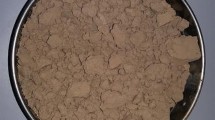Abstract
The number of the cities with canalized water and sewage treatment stations has increased lately and consequently having in mind the great concern on environment preservation and the quality of the water used by society. However, these stations are nowadays causing another kind of problem: a huge quantity of sludge as residue. Due to the implication of the residue on the environment and, consequently, to human life quality, performing of an accurate investigation about the components of such sludge, as well as the thermal stability of this residue in the environment become necessary. This paper presents a study on sludge from water and sewage treatment station, as well as the thermal characterization of residue. Such study was performed through FTIR, atomic absorption, thermoanalytical (TG/DTG, DTA) techniques, that made it possible to observe that the main components of the sludge are clay, carbonates and organic substance, presenting a low rate of metals and a unique thermal behavior since the sludge from the treatment station has a higher thermal stability.




Similar content being viewed by others
References
IBGE 2000, Pesquisa nacional de saneamento básico. http://www.ibge.gov.br/home/defaut.php. Accessed 3 Dec 2007.
Rocha MT, Shirota R, Disposição final de lodo de esgoto. Revista de Estudos Ambientais 1999; 1: set/dez.
Otero M, Calvo LF, Gil MV, Garcia AI, Moran A. Co-combustion of different sewage sludge and coal: a non-isothermal thermogravimetric kinetic analysis. Biores Technol. 2008;99:6311–9.
Shao J, Yan R, Chen H, Wang B, Ho Lee D, Liang DT. Pyrolysis characteristics and kinetics of sewage sludge by thermogravimetry Fourier transform infrared analysis. Energy Fuels. 2008;22:38–45.
Ischiam M, Perazolli C, Maschior DAL, Campostrini R. Pyrolysis study of sewage by TG-MS and TG-GC-MS coupled analyses. J Thermal Anal Calorim. 2007;87:567–74.
Malliou O, Katsioti M, Georgiadis A, Katsiri A. Properties of stabilized/solidified admixtures of cement and sewage sludge. Cement Concr Compos. 2007;29:55–61.
Bettiol W, Camargo OA. Impacto ambiental do uso agrícola do lodo de esgoto. Jaguariúna: EMBRAPA Meio Ambiente; 2000.
Otero M, Sanchez ME, Garcia AI, Moran A. Simultaneous thermogravimetric-mass spectrometric study on the combustion of coal and sewage sludges. J Therm Anal Calorim. 2006;86:489–95.
Decisão De Diretoria nº 195-2005- E, de 23 de novembro de 2005. Dispõe sobre a aprovação dos Valores Orientadores para Solos e Águas Subterrâneas no Estado de São Paulo. http://74.125.45.132/custom?q=cache:2U7hah1yplsJ:www.cetesb.sp.gov.br/Solo/relatorios/tabela_valores_2005.pdf+diretoria,+2005&cd=1&hl=pt-BR&ct=clnk&client=google-coop-np. Accessed 23 Aug 2008.
Silva FC; Boaretto AE, Berton RS, Zotelli HB,Pexe CA, Bernardes CM. Efeito de lodo de esgoto na fertilidade de um argissolo vermelho-amarelo cultivado com cana-de-açúcar. Campinas: EMBRAPA; 2002. http://www.repdigital.cnptia.embrapa.br/handle/CNPTIA/8636. Accessed 23 Aug 2008.
Oliveira EMS, Machado SQ, Holanda JNF. Caracterização de resíduo (lodo) proveniente de estação de tratamento de águas visando sua utilização em cerâmica vermelha. Cerâmica. 2004;50:324–30.
Nakamoto K. Infrared and Raman spectra of inorganic and coordination compounds. 5th ed. New York: Wiley; 1997.
Smidt E, Meissl K. The applicability of Fourier transform infrared (FT-IR) spectroscopy in waste management. Waste Manag. 2007;27:268–76.
Canellas LP, Santos GA, Rumjanek VM, Moraes AA, Guridi F. Distribuição da matéria orgânica e característica de ácidos humicos em solos com adição de resíduos de origem urbana. Pesq Agrop Bras. 2001;61:268–76.
Cardona BT, Fluente IG. Obtencion de fases del cemento utilizando desechos agicolas e industriales. Ciência Uanl 2002;V:190–96.
Munoz SIS. Impacto Ambiental na Área do Aterro Sanitário e Incinerador de Resíduos Sólidos de Ribeirão Preto, SP. Avaliação dos níveis de metais pesados. Tese de Doutorado. Ribeirão Preto – USP;2002.
Author information
Authors and Affiliations
Corresponding author
Rights and permissions
About this article
Cite this article
Capana, A.S., Martins, Q.V., Crespi, M.S. et al. Thermal behavior of residues (sludge) originated from Araraquara water and sewage treatment station. J Therm Anal Calorim 97, 601–604 (2009). https://doi.org/10.1007/s10973-009-0361-4
Published:
Issue Date:
DOI: https://doi.org/10.1007/s10973-009-0361-4




